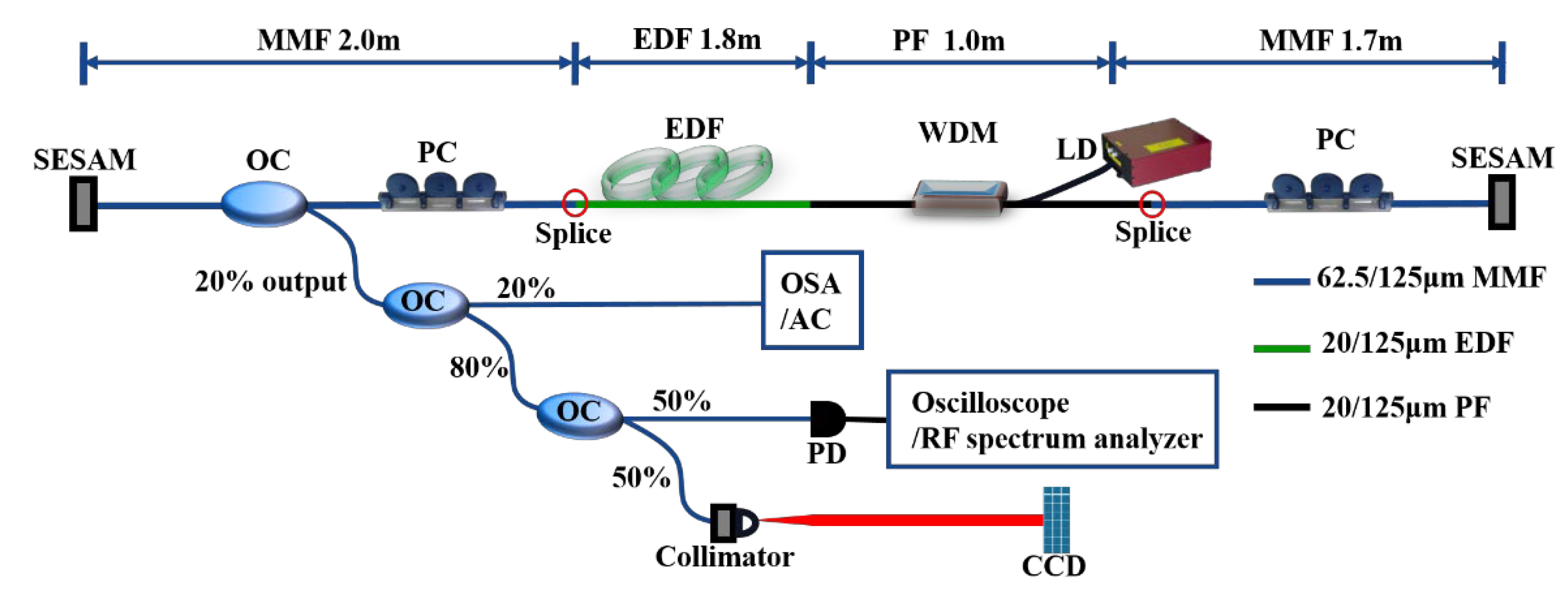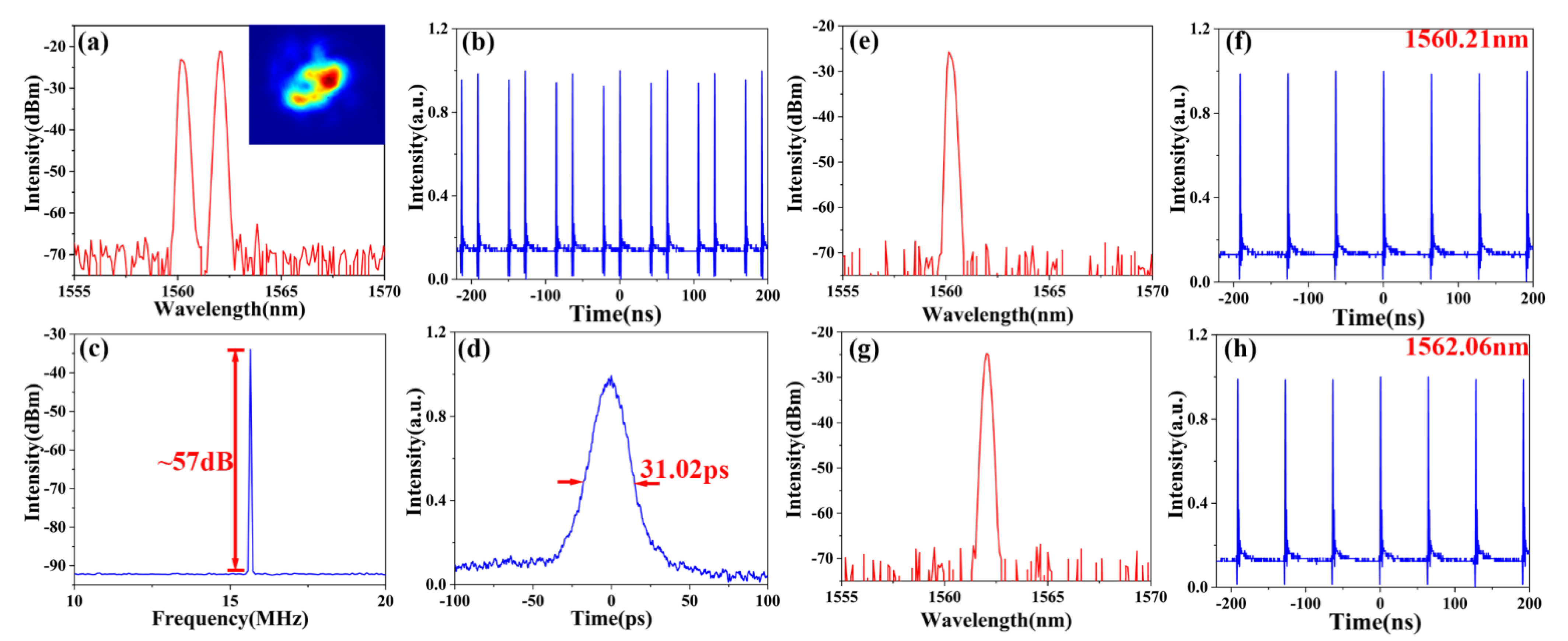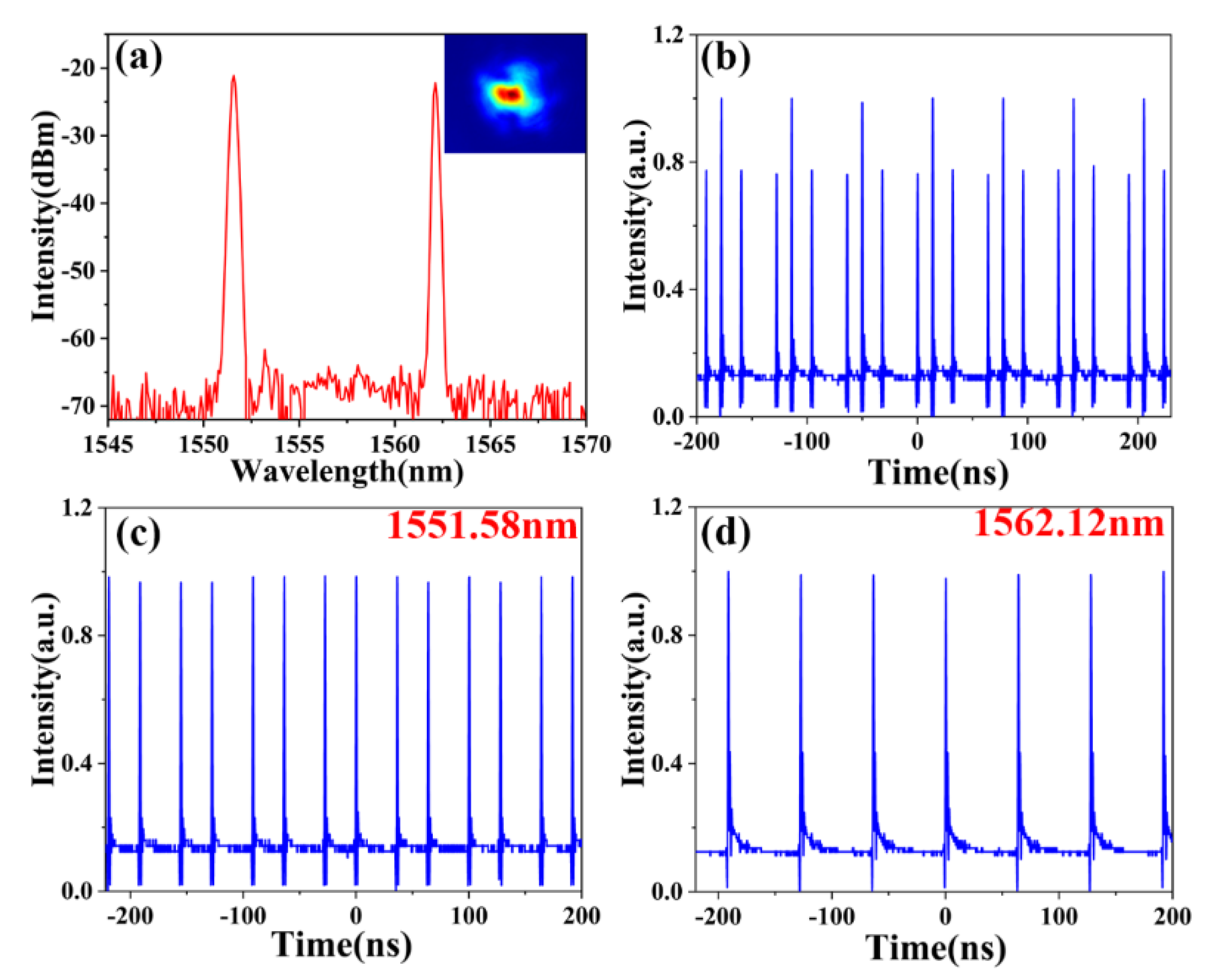1. Introduction
In recent years, multimode fibers (MMFs) have received increasing attention due to the limitations of pulse energy in mode-locked single-mode fiber lasers. Theoretically, mode-locked (spatiotemporal mode-locked, STML) MMF lasers have three orders of magnitude higher pulse energy than conventional mode-locked single-mode fiber lasers, which provides a simple solution to achieve high-energy pulses [
1]. The transverse mode freedom of MMFs allows optical pulses to generate more complex and rich phenomena, such as beam self-cleaning [
2], multimode solitons [
3], geometric parameter instability [
4], and spatiotemporal light-beam compression [
5]. Due to the increase in mode freedom, the spatiotemporal mode-locking requires simultaneously locked longitudinal and transverse modes, which are the main challenge that hinders its realization. In 2017, the first STML fiber laser has been demonstrated with the low modal dispersion of the gradient refractive index (GRIN) MMF [
6]. With this pioneering work, a series of STML phenomena were reported with similar spatial optical paths, such as soliton molecules [
7], multiple pulses [
8], self-similar pulses [
9], and dispersion-management pulses [
10]. Particularly, the STML laser with the large modal dispersion is also demonstrated [
11]. At the same time, the all-fiber STML laser has also been developed with the linear resonant cavity [
12,
13] and figure-eight cavity [
14]. These research results contribute to the exploration of the mechanism and characteristics of spatiotemporal mode-locking. However, the study on the STML fiber lasers is still in its infancy, and further exploration of multifunctional STML lasers is still an attractive topic.
On the other hand dense wavelength division multiplexing (DWDM) and optical time division multiplexing (OTDM) are effective ways to achieve the upgrade and expansion of optical fiber communication, and the corresponding key technology is the generation of multi-wavelength signals and ultra-short optical pulses with high repetition rates [
15]. Multi-wavelength fiber lasers (MWFLs) can provide signals for multiple channels and act as an ideal light source for long-range, high-capacity optical fiber communication systems [
16]. In addition, MWFLs are also widely used in optical measurements [
17], microwave photonics [
18], and other fields. Therefore, the development of MWFLs is undoubted of great significance. The traditional filter structures, such as Mach–Zehnder interferometer [
19], Fabry–Perot interferometer [
20], Sagnac interferometer [
21], Michelson interferometer [
22], Lyot Filter [
23], and different types of fiber gratings cascaded [
24], have been demonstrated to achieve the tunable MWFLs. However, the limited tunability of these filters greatly hinders their applications. Recently, filters based on the multimode interference (MMI) effect have attracted significant attention. In MMFs, signals of different wavelengths can propagate in paths with various mode components, and then, they exhibit wavelength-dependent transmission characteristics relying on the self-imaging effect of MMFs [
25]. The MMI effect is obtained by the splicing of different fibers with the MMFs generally, which allows the filters low cost and simple operation [
26]. Here, the MMF-based STML laser provides a convenient physical basis for the MMI due to the different core diameters between the gain fiber and the MMF. Meanwhile, this spontaneously formed filter not only effectively avoids the insertion loss introduced by the extra tunable devices but also facilitates the formation of multifunctional STML lasers. Furthermore, multifunctional STML lasers enrich the characteristics of spatiotemporal mode-locking while expanding its potential applications. In spite of these fascinating opportunities, multifunctional STML lasers have rarely been reported.
In this work, we demonstrate, to the best of our knowledge, the first tunable multi-wavelength STML laser operating at 1.55 μm. The laser adopts an all-fiber linear, resonant structure that exploits the core diameter mismatch of the fibers as the light oscillates back and forth in the laser to achieve an MMF-few-mode fiber-MMF (M-F-M) MMI filter. This naturally formed M-F-M filter provides a simple and effective method to achieve the tunable laser, which avoids the insertion loss and complexity associated with additional tunable devices. Meanwhile, benefiting from the MMI filtering effect, not only the central wavelength can be continuously tuned from 1552.93 nm to 1572.64 nm, but also the wavelength interval can be adjusted from 2 nm to 19 nm while maintaining a stable output state. Moreover, the spectral channels can be consecutively increased from 2 to 4. Please note that these features can be achieved simply by adjusting the polarization controllers (PCs). This multifunctional laser provides a reliable research platform for further understanding and exploring the physical mechanisms of the spatiotemporal mode-locking. Furthermore, this tunable STML laser operates in a low-loss waveband, which is not only beneficial for the integration of existing communication networks to improve the communication capacity, but also has potential applications in sensing, microwave generation, spectral analysis, information coding, and lidar, etc.
2. Experimental Setup and Results
The experimental setup for the multi-wavelength STML fiber laser is shown in
Figure 1. The laser employs an all-fiber linear resonant structure with a total length of about 6.5 m. It consists of a 1.8 m long step-index erbium-doped fiber (EDF, Er1200-20/125SC, FORC, RAS), a passive fiber (PF, 20/125SC) matched to the EDF, and two segments of the commercially available Corning 62.5/125 μm grade-index (GRIN) MMFs. Two semiconductor saturable absorber mirrors (SESAMs, BATOP, SAM-1550-30-5ps-x) are placed symmetrically at both ends of the laser cavity, acting as a reflector to construct a linear oscillator and introducing a spatiotemporal saturable absorption effect to help establishing spatiotemporal mode-locking. The EDF is pumped by a 980 nm laser diode (LD, PSS-980-750-B-FBG, YM lasers) through the customized wavelength-division-multiplexer (WDM). Since the laser cavity includes fibers with different core diameters, i.e., 20/125 μm few-mode fiber (EDF/WDM PF) and 62.5/125 μm GRIN MMF, respectively. These two fiber types form mismatched points at the fusion cross-section, which not only result in fusion loss but also cause mode excitation and coupling. As the light oscillates back and forth in the cavity, the mode excitation and coupling introduce wavelength-dependent transmission, namely, the MMI filtering effect, which can act as a tunable wavelength selector. Moreover, the length of MMF is critical for adjusting its filtering properties [
12]. The PC placed on the MMF can slightly adjust the length of the MMF to synchronously adjust the transmission characteristics of the filter and the mode proportion of the pulse [
13], which determines the laser output state. Meanwhile, 20% of the power is output from the optical coupler (OC) for detection. Benefiting from the all-fiber design of the laser cavity, the STML output can be easily divided into multiple signals by the OC for measurement. The measurement system for the STML characterization includes an optical spectrum analyzer (OSA, Yokogawa, AQ6317C), an oscilloscope (Tektronix, DSA71604B, 16 GHz) with a photodetector (PD, Newport, 1623 InGaAs nanosecond optical detector), a radio-frequency (RF) spectrum analyzer (Agilent, E4407B ESA-E SERIES, 26.5 GHz) and an autocorrelator (AC, Femtochrome, FR-103WS). The beam profile is captured by a charge-coupled device (CCD) camera (Goldeye G-033SWIR TEC1).
In the experiment, when the pump power reaches 160 mW, the multi-wavelength STML operation can be easily generated by properly adjusting the PCs.
Figure 2 shows the typical characteristics of the dual-wavelength STML state. As shown in
Figure 2a, the central wavelengths are 1560.21 nm and 1562.06 nm, respectively. Similar to the previous reports [
13], the spectrum of each channel is narrow with a 3-dB bandwidth of 0.5 nm. Note that the different spectral intensities are mainly caused by the wavelength-dependent transmission loss of the MMI filter [
25]. As inset in
Figure 2a, the non-Gaussian distribution of the beam profile, which is a typical characteristic of spatiotemporal mode-locking, indicates that the output signal contains many higher-order modes [
6,
7,
8,
9,
10,
11,
12,
13].
Figure 2b shows the pulse-train of the dual-wavelength laser output, which is consistent with the fundamental repetition rate of the cavity. As illustrated in
Figure 2c, the signal-to-noise ratio is about 57 dB, which indicates that the spatiotemporal mode-locking operates with good stability. The autocorrelation trace exhibited in
Figure 2d shows a 31.02 ps duration with full width at half maximum by the Gaussian shape assumption. To further investigate the characteristics of the dual-wavelength STML state, we use a waveshaper (Finisar WaveShaper 4000A) to separate each wavelength and measure its characteristics. It should be noted that due to the loss of power and mode components introduced by the waveshaper, we only measure the filtered wavelength information and its pulse sequence, which is sufficient to prove its mode-locked state.
Figure 2e–h show the resolved spectra and pulse-trains at different wavelengths, respectively. Comparing
Figure 2f,h, we find that although the two pulse sequences correspond to different wavelengths, the spacing of the pulses is consistent with the fundamental repetition rate of the STML laser. Therefore, each wavelength is not only in a stable mode-locked state, but also the two wavelength channels correspond to the pulse-train in same state.
Maintaining the pump power and rotating the PCs, the laser produces another dual-wavelength STML operation where the characteristics of solitons are quite different. As shown in
Figure 3a, the dual-wavelength STML state operates at 1551.58 nm and 1562.12 nm, respectively. This state has a narrower spectral width and the left channel of the dual-wavelength produces a significant drift of about 10 nm. The main reason is that the squeezed PC changes the MMF length and the transmission curve of the MMI filter drifts with the MMF length. From the pulse-train in
Figure 3b, the laser shows a triple-pulse mode-locked state and there is a clear difference in the intensity of the pulses. The pulses can be divided into two distinct parts, namely, a higher pulse and a lower pulse pair. In this case, we further investigate that each wavelength channel corresponds to pulse-train in a completely different state. After channel separation, we find that the channel located at 1551.58 nm corresponds to pulse pairs, while the other wavelength corresponds to a single-pulse state, as shown in
Figure 3c,d, respectively. We speculate that there are two reasons, the first is the wavelength-dependent transmission loss of the MMI filtering [
25]. The second is the EDF gain fiber with different wavelength gain. In contrast, the gain fiber has a higher gain at 1551.58 nm. When the nonlinear effect accumulated in the channel is excessive, it will cause pulse splitting and form multiple pulses. Therefore, different channels exhibit different pulse-trains. During the rotation of the PCs, we also observe multiple different dual-wavelength pulse patterns, such as 1 pulse + 3 pulses and 2 pulses + 2 pulses. These results also indicate that multiple pulses are prevalent in STML fiber lasers.
Under the previously mentioned mode-locked state and the pump power at 160 mW, the laser further shows tunable capabilities both in the central wavelength and wavelength spacing by simply adjusting the PCs. The spectrum of the dual-wavelength STML operation can be tuned to different wavelengths, as shown in
Figure 4a. The spectrum has a tuning range of about 19.7 nm (1552.93 nm to 1572.64 nm). This tunability is mainly attributed to the filter transmission curve generated by the MMI, whose overall variability results in a tunable central wavelength. As the light oscillates back and forth in the laser, the MMI effect is constantly introduced, so the STML laser has good wavelength-tunability. Meanwhile, the laser also has an adjustable range in wavelength spacing.
Figure 4b shows the dual-wavelength STML states with different wavelength spacing, and the spacing varies from 2 nm to 19 nm. When rotating the PCs, not only the length of the MMF is changed, but also the mode energy is redistributed. As a result, the transmission peak spacing changes when the modes interfere, resulting in an adjustable wavelength spacing accompanied by a variation in the bandwidth of each spectrum.
Furthermore, the channels of the spectrum also exhibit tunability. We achieve an increasing channel number of the spectrum from 2 to 4, which is demonstrated in
Figure 5. As shown in
Figure 5a, two channels of dual-wavelength state are at 1559.96 nm and 1561.90 nm, respectively. However, with the rotation of the PCs, the new mode-locked channel is slowly formed at 1558.30 nm with relatively low spectral intensity. At the same time, there is a slight redshift of the mode-locked spectrum with the number of channels constantly increasing, as depicted in
Figure 5b. This phenomenon is mainly due to the reduced transmission loss of the filter, which increases the power operating in the laser, thus inducing a corresponding redshift of the mode-locked spectrum.
Figure 5c shows the four channels located at 1560.51 nm, 1562.20 nm, 1563.63 nm, and 1565.33 nm, respectively. As the number of mode-locked channels increases, the spacing between channels also varies. In agreement with our previous analysis, the main reason is that manipulating the PCs changes the length of the MMF and also affects the filtering bandwidth caused by the MMI. The evolution of the beam profiles in the inset shows that with the simultaneous locking of different channels, the beam spots correspondingly change. It is worth noting that these differences in distribution and size are mainly due to the different energy distributions between the fundamental and higher-order modes. If the energy of the high-order modes is relatively high, the mode distribution of the beam spot becomes larger and more scattered.
In this multi-wavelength STML laser, we note that this all-fiber laser utilizes its structure to naturally form an M-F-M MMI spectral filter without adding additional complexity as well as insertion loss. This simple and effective tunable multi-wavelength filter enables laser output control by simply rotating the PCs, which is very convenient for practical applications. In dual-wavelength state not only the central wavelength can be continuously tuned from 1552.93 nm to 1572.64 nm, but also the wavelength spacing can be adjusted from 2 nm to 19 nm. As the light oscillates back and forth in the laser, the MMI effect is constantly introduced, which allows us to consecutively increase the number of spectral channels from 2 to 4. These adjustable features further expand the potential application areas of STML fiber lasers, such as optical communications, microwave photonics, time-resolved pump-probe-based spectroscopy, nonlinear microscopy, optical parametric amplification, coherent pulse synthesis, etc. At the same time, this narrow mode-locked spectrum avoids the spectral overlap caused by the proximity of the multiple wavelengths. However, the narrow spectral width tends to produce the multiple pulses, which limits the peak power of the pulses. Therefore, we can construct an STML fiber laser with appropriate parameters to emit narrower ultrashort pulses with higher pulse energy. Note that, although the multi-pulse limits the development of STML lasers in some applications such as laser processing, laser medical treatment, and military defense, they are important in higher-order harmonic generation and information encoding.











